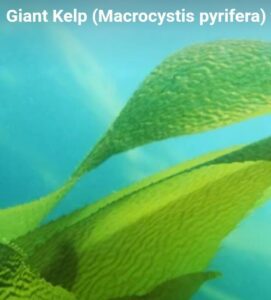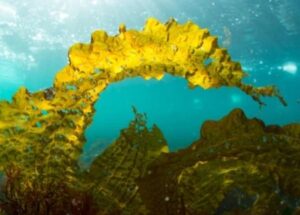Introduction
Giant kelp‘s scientific name, Macrocystis pyrifera, literally translates to “large bladder-bearing pear-shaped plant,” aptly describing its appearance. This remarkable algae can grow at astonishing rates, sometimes as much as two feet (60 centimeters) per day, reaching lengths of up to 100 feet (30 meters) or more. It typically anchors itself to rocky substrates on the seafloor, using holdfasts that secure it in place.
The range of giant kelp spans along the Pacific coast of North America, from Alaska to Baja California, and extends across the Southern Hemisphere, including the coasts of South America, Australia, and New Zealand. These locations provide the ideal conditions of cold, nutrient-rich waters and stable substrates necessary for its rapid growth.
Giant kelp forests are incredibly biodiverse environments, housing a plethora of marine life. The kelp’s sturdy stipes (stems) and fronds (leaves) create a three-dimensional underwater habitat that offers shelter, food, and protection for various organisms. Fish, invertebrates, sea otters, seals, and numerous other marine creatures rely on these forests for food and shelter.
Besides its ecological importance, giant kelp plays a significant role in marine carbon sequestration. As it photosynthesizes, it absorbs carbon dioxide from the atmosphere, helping mitigate the impacts of climate change by storing carbon in the form of biomass.
However, like many marine ecosystems, giant kelp forests are susceptible to human-induced disturbances. Climate change, ocean acidification, coastal development, and pollution can pose threats to their existence and biodiversity. Conservation efforts are crucial to protect and preserve these valuable marine ecosystems for the benefit of both marine life and human communities.

-
Unveiling the Giant Kelp’s Magnificence
It is a type of brown algae known for its astonishing growth rate, reaching up to 2 feet (60 cm) per day. These colossal marine plants can tower up to 100 feet (30 meters) in height, with their stipes (stems) anchored to the ocean floor and their blades (leaves) extending towards the surface. The blades are broad and leaf-like, providing a vital role in photosynthesis.
- A Towering Presence
It stands as a true titan of the underwater realm. Rising from the ocean floor, its stipes stretch towards the surface, reaching astonishing heights of up to 100 feet (30 meters). These towering structures are anchored by holdfasts, which grip the rocky substrate with remarkable strength. From these anchors, its’s long and slender blades extend upwards, capturing sunlight in a delicate dance with the waves.
- A Symphony of Adaptations
Surviving in the dynamic marine environment requires a repertoire of adaptations, and its boasts an impressive array. Its ability to grow rapidly—up to 2 feet (60 cm) per day—relies on its capacity to absorb nutrients from the surrounding water. Its blades are equipped with gas-filled bladders called pneumatocysts, providing buoyancy and allowing them to remain afloat, maximizing their exposure to sunlight.
- A Sunlit Feast
Photosynthesis serves as the lifeblood of the it, fueling its incredible growth. Sunlight penetrates the upper layers of the ocean, providing the necessary energy for the process. The blades of this kelp are adorned with chloroplasts, tiny green organelles responsible for harnessing the sun’s energy and converting it into vital nutrients. Through this remarkable photosynthetic prowess, the giant kelp becomes a nourishing banquet for a multitude of marine creatures.
- An Ecosystem Within
It’s forest emerges as a vibrant and interconnected ecosystem, housing a diverse array of marine organisms. Like a bustling metropolis, it serves as a haven for countless species, from fish to invertebrates, and even marine mammals. The towering kelp blades provide shelter and protection, while the holdfasts offer a secure anchor for a multitude of creatures to call home. These underwater forests foster biodiversity, nurturing the delicate balance of life beneath the waves.
- The Circle of Life
Within the kelp forest, a complex web of interactions unfolds. Tiny organisms, such as zooplankton, graze upon the kelp’s blades, sustaining themselves on the rich nutrients it provides. In turn, larger herbivores, such as sea urchins and snails, feast on the kelp, their presence kept in check by natural predators. Meanwhile, predators such as fish and sea otters hunt within the forest, maintaining a harmonious equilibrium. This interconnectedness weaves a tapestry of life, highlighting the intricate beauty of nature’s design.
- A Natural Protector
It’s forest serves as a guardian of the coastlines, offering protection against the relentless forces of the ocean. As waves approach the shore, the presence of the kelp dampens their energy, reducing the impact of erosion and preserving the stability of coastal ecosystems. In this way, the giant kelp stands as a natural fortress, defending the fragile land-sea interface.
- A Fragile Balance
The magnificence of the kelp and its surrounding ecosystem faces numerous threats. Climate change, rising sea temperatures, and ocean acidification all pose significant challenges to its survival. Human activities, such as overfishing and pollution, further disrupt the delicate balance of this underwater wonderland.
2. A Symphony of Adaptations
kelp possesses an array of adaptations that enable it to thrive in its unique marine habitat. Their remarkable growth is fueled by their ability to absorb nutrients from the surrounding water, mainly through their holdfasts a structure that anchors them to the ocean floor. Gas-filled bladders, called pneumatocysts, provide buoyancy, allowing the blades to reach sunlight at the ocean’s surface.

- Anchors of the Ocean
kelps are experts at anchoring themselves to the ocean floor, defying the relentless forces of currents and waves. Through a specialized structure known as the holdfast, giant kelps attach themselves firmly to rocky substrates, ensuring stability amidst the ever-changing underwater environment. The holdfasts, resembling a tangle of strong and resilient roots, provide a solid foundation for the towering kelps to grow.
- Reaching for the Sun
Sunlight is a precious resource in the depths of the ocean, and giant kelps have evolved a remarkable strategy to capture as much of it as possible. Their long and slender blades extend upwards, like arms stretching towards the sun. These broad, leaf-like structures maximize the kelps’ surface area, enabling them to absorb abundant sunlight for photosynthesis—the process by which they convert sunlight into energy.
- Buoyancy Boosters
To maintain their upright position and facilitate their upward growth, kelps employ buoyancy boosters called pneumatocysts. These gas-filled bladders, located within the blades and stipes of the kelp, act as flotation devices. By regulating the amount of gas within the pneumatocysts, giant kelps can adjust their buoyancy, ensuring that their blades remain optimally positioned to receive sunlight.
- Nutrient Mastery
Nutrients are vital for the growth and survival of any organism, and kelps have evolved ingenious ways to obtain and utilize them. They possess specialized structures on their blades, known as ruffles or frills, which increase their surface area. This design allows the kelps to effectively absorb essential nutrients, such as nitrogen and phosphorous, directly from the surrounding water. By efficiently harnessing these nutrients, giant kelps can sustain their rapid growth rates.
- Defense Mechanisms
Living in the marine environment exposes giant kelps to numerous threats, ranging from grazing animals to strong ocean currents. To protect themselves, these remarkable algae have developed an arsenal of defense mechanisms. One notable defense strategy is the production of chemical compounds. Giant kelps release deterrent chemicals into the water, discouraging herbivores from feeding on their blades and reducing the risk of damage.
- Rapid Growth Rates
One of the most astonishing adaptations of giant kelps is their rapid growth rate. Under ideal conditions, these algae can grow at an astonishing pace of up to 2 feet (60 cm) per day, making them among the fastest-growing organisms on the planet. Their ability to harness sunlight, efficiently absorb nutrients, and regulate buoyancy allows them to channel their energy into rapid vertical growth, reaching towering heights within weeks.
- Ecological Engineers
kelps play a crucial role as ecological engineers within their marine habitats. Their towering presence creates a three-dimensional underwater forest, offering shelter, protection, and feeding grounds for a multitude of organisms. The complex structure of the kelp forest provides habitats for numerous species, fostering biodiversity and promoting the survival of countless marine creatures.
-
The Underwater Forest Ecosystem
kelp forests are vibrant ecosystems teeming with life. These marine sanctuaries provide shelter, feeding grounds, and nursery habitats for an astonishing diversity of organisms. From sea otters to fish, sea urchins to snails, anemones to seals, the kelp forest serves as a sanctuary for a myriad of species, creating a delicate balance of interdependencies.

- The Forest beneath the Waves
kelp forests emerge as underwater forests, mesmerizing in their resemblance to terrestrial forests. The towering kelps, with their stipes anchored to the ocean floor and their long blades reaching upwards, create a dense canopy of magnificent proportions. This three-dimensional habitat provides a multitude of ecological niches and forms the foundation of a thriving ecosystem.
- A Haven for Biodiversity
The underwater forest of kelps harbors a remarkable diversity of marine life. It serves as a sanctuary and nursery for an abundance of organisms, from microscopic plankton to majestic marine mammals. The complex structure of the kelp forest offers a range of habitats, including sheltered areas amidst the blades, submerged understories, and the open water above. Each zone supports a unique assemblage of species, fostering biodiversity and ecological resilience.
- Shelter and Protection
The towering kelp blades provide a haven for countless organisms seeking shelter and protection. Fish seek refuge among the swaying fronds, utilizing the kelp forest as a nursery and feeding ground. The dense structure of the underwater forest shields small marine creatures from predation and reduces the impact of ocean currents, creating calm microenvironments in which life can thrive.
- Food Chain Connections
The underwater forest ecosystem of giant kelps weaves a delicate web of interconnectedness. The kelp blades, rich in nutrients, support a plethora of primary consumers such as sea urchins, snails, and crustaceans. These herbivores graze upon the kelp, regulating its growth and shaping the structure of the forest. In turn, the herbivores become prey for secondary consumers, including fish, sea otters, and marine birds. This intricate food web illustrates the interdependency of species within the kelp forest ecosystem.
- Oxygen Oasis
Photosynthesis, driven by the kelps, produces a substantial amount of oxygen within the underwater forest. As sunlight filters through the water and reaches the kelp blades, these incredible algae convert carbon dioxide into oxygen. The continuous process of photosynthesis releases oxygen into the surrounding water, benefiting the diverse array of organisms living within the kelp forest.
- Carbon Capture and Storage
kelps contribute significantly to mitigating climate change through their capacity for carbon capture and storage. These algae are among the most efficient carbon dioxide absorbers on the planet. As they photosynthesize, they draw carbon dioxide from the water and atmosphere, converting it into organic matter. By sequestering carbon within their tissues, kelps play a vital role in reducing greenhouse gas concentrations, helping to regulate the Earth’s climate.
- Threats and Conservation
Despite their resilience, the underwater forest ecosystem of giant kelps faces numerous threats. Climate change, including rising sea temperatures and ocean acidification, poses significant challenges to the health and survival of these forests. Pollution, overfishing, and destructive human activities further compound the risks. Recognizing the importance of these habitats, conservation efforts focus on creating marine protected areas, promoting sustainable fishing practices, and raising awareness about the critical role of kelp forests in maintaining healthy oceans.
-
Ecological Importance
kelp forests play a critical role in maintaining the health of our oceans and the planet as a whole. They act as carbon sinks, absorbing and storing vast amounts of carbon dioxide from the atmosphere. Their rapid growth rate, paired with their high carbon absorption capacity, contributes to mitigating climate change. Additionally, these underwater forests protect coastlines from erosion by dampening the force of waves.
- Carbon Sequestration and Climate Regulation
kelps are exceptional carbon sequesters, absorbing substantial amounts of carbon dioxide from the water and atmosphere through their photosynthetic activity. Their rapid growth rate and efficient carbon uptake make them formidable contributors to mitigating climate change. By capturing and storing carbon within their tissues, giant kelps help regulate global carbon dioxide levels, reducing greenhouse gas concentrations and combating the effects of climate change.
- Oxygen Production
Through photosynthesis, giant kelps generate vast amounts of oxygen. Sunlight penetrates the water, reaching their extensive blades, and triggers the conversion of carbon dioxide into oxygen. This process is fundamental to sustaining marine life and maintaining oxygen balance in the oceans. The underwater forests of giant kelps serve as oxygen oases, providing a critical source of this life-sustaining gas for a myriad of organisms residing in their vicinity.
- Habitat and Biodiversity
kelp forests create a diverse and intricate habitat, fostering an astonishing array of marine life. The dense structure of the kelp blades offers shelter, protection, and feeding grounds for a multitude of organisms. Fish, invertebrates, marine mammals, and countless other species call the kelp forest home. From tiny crustaceans seeking refuge to sea otters hunting for food, the intricate web of life within the kelp forest thrives on the abundance of resources provided by giant kelps.
- Nursery and Feeding Grounds
The underwater forest of kelps serves as a nursery and vital feeding ground for various marine species. The complex structure of the kelp blades provides safe spaces for the reproduction and early development of many organisms. Fish larvae find refuge in the kelp forest, benefiting from the protection against predation and access to an ample food supply. The abundance of invertebrates, such as sea urchins and snails, sustains the growth and survival of numerous species within the ecosystem.
- Erosion Control and Coastal Protection
The presence of kelp forests plays a vital role in mitigating coastal erosion. The complex root-like holdfasts of giant kelps stabilize the ocean floor, reducing the impact of waves and currents. As waves approach the shore, the kelp blades dampen their energy, acting as a natural buffer that protects coastlines from erosion. By anchoring the substrate and mitigating wave energy, giant kelps contribute to the stability and integrity of coastal ecosystems.
- Nutrient Cycling and Water Quality
kelps actively participate in nutrient cycling, a fundamental process that ensures the availability of essential elements within the marine ecosystem. Through their uptake and storage of nutrients, including nitrogen and phosphorous, giant kelps contribute to maintaining water quality. By removing excess nutrients from the water column, they help prevent eutrophication—a phenomenon that leads to harmful algal blooms and oxygen-depleted “dead zones.”
- Conservation and Restoration
Recognizing the ecological importance of kelps, conservation efforts are underway to protect and restore their habitats. Establishing marine protected areas and implementing sustainable fishing practices are crucial steps towards preserving these underwater forests.
-
Threats to Giant Kelp
Despite their resilience, kelp forests face several challenges that jeopardize their survival. Climate change, rising sea temperatures, ocean acidification, and extreme weather events pose significant threats to the health and vitality of these underwater ecosystems. Overfishing and pollution further compound these issues, disrupting the delicate balance of the kelp forest ecosystem.
- Climate Change
Climate change poses a significant threat to giant kelp forests. Rising sea temperatures can cause stress and disrupt the delicate balance of the kelp ecosystem. Higher water temperatures can lead to decreased kelp growth rates and increased susceptibility to diseases. Additionally, climate change-induced ocean acidification can impede the ability of giant kelps to build their calcium carbonate structures, weakening their overall resilience.
- Storms and Wave Action
Intense storms and powerful wave action can wreak havoc on kelp forests. These underwater forests are constantly exposed to the forces of nature, and extreme weather events can uproot or break off kelp plants, damaging their structural integrity. Large waves can also dislodge and wash away the delicate spores necessary for the kelps’ reproduction, hindering their ability to regenerate and expand their populations.
- Overfishing and Harvesting
Overfishing and unsustainable harvesting practices pose a significant threat to kelp populations. Kelp forests provide important habitats for commercial and recreational fish species, and their removal can disrupt the delicate balance of the ecosystem. Excessive harvesting of giant kelps for various purposes, including food, fertilizers, and cosmetics, can deplete their populations, compromising the overall health and stability of the underwater forest.
- Pollution and Runoff
Pollution from human activities, including coastal development, industrial runoff, and oil spills, can have detrimental effects on giant kelp forests. Chemical pollutants can accumulate in the kelp tissues, affecting their growth and reproductive capabilities. Sediment runoff, particularly from land-based activities such as deforestation and construction, can smother the kelp and reduce sunlight penetration, hindering their photosynthetic capacity.
- Herbivore Overpopulation
Imbalances in herbivore populations can pose a significant threat to kelp forests. When natural predators, such as sea otters, are absent or their populations decline, herbivorous grazers like sea urchins can proliferate unchecked. In such situations, sea urchins can overgraze on giant kelp, decimating entire forest ecosystems. This overgrazing disrupts the delicate balance of the underwater food web and can lead to the formation of “urchin barrens” devoid of kelp.
- Invasive Species
The introduction of invasive species can have devastating consequences for kelp forests. Non-native species, such as the invasive seaweed Sargassum muticum, can outcompete native giant kelps for resources and space, displacing them and altering the composition of the underwater ecosystem. Invasive species can disrupt the intricate relationships within the kelp forest, jeopardizing the survival of many organisms that depend on the native kelp habitat.
- Insufficient Protection and Awareness
The lack of sufficient protection and awareness poses a significant threat to kelp forests. Without designated marine protected areas and conservation measures, these underwater wonders are vulnerable to human activities that degrade their habitats. Raising awareness about the ecological importance of giant kelp and advocating for their conservation is crucial to ensure their long-term survival.
-
Conservation Efforts
Recognizing the importance of giant kelp forests, scientists and conservationists have initiated efforts to protect and restore these unique habitats. Marine protected areas, such as marine reserves and national parks, help safeguard kelp forests from human activities. Promoting sustainable fishing practices, reducing pollution, and advocating for climate change mitigation are essential steps towards preserving these vital ecosystems.

- Marine Protected Areas
One of the most effective conservation strategies for giant kelps is the establishment of marine protected areas (MPAs). These designated zones provide legal protection for marine habitats and species, including the kelp forests. MPAs help regulate human activities such as fishing, anchoring, and coastal development, reducing the impact of human-induced stressors on kelp ecosystems. By preserving these areas, MPAs contribute to the recovery and resilience of giant kelp populations.
- Sustainable Fishing Practices
Promoting sustainable fishing practices is vital for the conservation of kelp forests. Overfishing and indiscriminate harvesting of kelp can disrupt the delicate balance of the ecosystem. Implementing measures such as catch limits, size restrictions, and gear modifications can help ensure the sustainable use of kelp resources. Collaborative efforts between fishing communities, scientists, and regulatory bodies aim to strike a balance between human needs and the preservation of kelp habitats.
- Restoration and Reforestation
Restoration and reforestation initiatives play a pivotal role in reviving degraded or damaged kelp forests. These efforts involve the active planting of kelp individuals or the rehabilitation of degraded areas to encourage the reestablishment of kelp populations. Restoration projects often focus on addressing the primary drivers of decline, such as controlling herbivore populations or removing invasive species. By enhancing kelp habitats, restoration endeavors contribute to the recovery and expansion of the underwater forests.
- Monitoring and Research
Continuous monitoring and research efforts are essential for understanding the dynamics of giant kelp ecosystems and informing conservation strategies. Scientists employ various methods, such as underwater surveys, satellite imagery, and ecological modeling, to assess the health and distribution of kelp forests. Long-term monitoring allows for the early detection of changes and threats, providing valuable data to guide conservation efforts and adaptive management practices.
- Public Education and Awareness
Raising public awareness about the ecological importance of kelps is crucial for their conservation. Educational programs, public outreach initiatives, and community engagement efforts help disseminate knowledge about the role of kelp forests in maintaining healthy marine ecosystems. By fostering a sense of appreciation and stewardship, public education efforts inspire individuals to take action and support conservation measures that protect these underwater wonders.
- Collaborative Partnerships
Conservation efforts for kelps thrive on collaborative partnerships among various stakeholders. Scientists, conservation organizations, policymakers, local communities, and indigenous groups work together to develop effective strategies and policies. By leveraging collective expertise, sharing resources, and engaging in cooperative decision-making processes, these partnerships amplify the impact of conservation initiatives and ensure a holistic approach to safeguarding giant kelp ecosystems.
- Climate Change Mitigation
Recognizing the significant impact of climate change on kelps, efforts to mitigate and adapt to its effects are crucial. Reducing greenhouse gas emissions and advocating for sustainable practices that address the root causes of climate change are essential. Additionally, promoting resilience-building strategies, such as protecting kelp habitats from additional stressors, can enhance the ability of kelp forests to withstand changing environmental conditions.
-
Exploring Giant Kelp Forests
Witnessing the majesty of giant kelp forests firsthand is a transformative experience. Snorkeling or scuba diving in these underwater realms allows you to marvel at the beauty and diversity of life that thrives within them. Many coastal regions around the world offer guided tours or opportunities for visitors to explore these underwater wonderlands while adhering to responsible ecotourism practices.
- The Towering Giants
kelps, also known as Macrocystis pyrifera, are the true giants of the underwater world. Rising from the ocean floor, these remarkable algae can reach extraordinary heights, with their elongated stalks, known as stipes, supporting long, leaf-like blades that extend towards the surface. The towering canopy formed by these kelps creates a three-dimensional underwater forest, casting dappled sunlight and shaping a unique ecosystem.
- A Symphony of Life
kelp forests are teeming with life, offering a symphony of colors, shapes, and textures. As you dive into the forest, you’ll be greeted by an array of marine creatures that have adapted to this habitat. Vibrant fish dart among the swaying kelp fronds, seeking shelter and sustenance. Invertebrates cling to the kelp blades, adding pops of color to the underwater landscape. Sea otters playfully frolic, feeding on sea urchins that graze on the kelp. Each encounter reveals the intricate web of life that thrives within these forests.
- A Diverse Habitat
The complexity of kelp forests provides a range of habitats for a diverse array of marine species. The towering kelp blades offer shelter, protection, and feeding grounds for numerous organisms. Some creatures, like the Garibaldi fish and kelp bass, seek refuge among the fronds. Others, like crabs and snails, scuttle along the kelp stipes, finding hiding spots and scavenging for food. The underwater forest supports an incredible variety of life, from microscopic plankton to majestic sea lions.
- Nursery for Marine Life
kelp forests serve as vital nurseries for many marine species. The dense structure of the kelp blades provides a safe haven for the reproduction and early development of various organisms. Fish eggs are laid among the kelp fronds, protected from predators. Juvenile fish find shelter and abundant food within the forest, enabling them to grow and mature. The kelp forest acts as a nursery, nurturing the next generation of marine life and contributing to the overall biodiversity of the ocean.
- Photosynthetic Marvels
kelps are extraordinary photosynthetic organisms. Through the process of photosynthesis, they convert sunlight, carbon dioxide, and nutrients into energy and oxygen. The sunlight filtering through the water is captured by the kelp blades, fueling their growth and creating a vibrant underwater oasis. As a byproduct of photosynthesis, giant kelps release oxygen into the water, providing a crucial source of this life-sustaining gas for the entire ecosystem.
- Ephemeral Beauty
The beauty of kelp forests is ever-changing and transient. Seasonal variations and oceanic currents influence the growth and appearance of the forest. In summer, the kelp blades grow thick and lush, creating a dense canopy that sways with the ocean currents. In winter, stormy conditions can cause the forest to diminish temporarily, only to regenerate and flourish again in the following seasons.
Conclusion:
Giant kelp forests are true marvels of the underwater world, captivating us with their towering presence and enchanting beauty. These underwater forests not only provide a sanctuary for an astounding array of marine life but also play a vital role in the health and balance of our oceans. Exploring the majesty of kelp forests unveils a world brimming with vibrant colors, intricate interactions, and awe-inspiring adaptations.
As we venture into the depths of these underwater wonderlands, we witness the towering giants that sway with the ocean currents, offering shelter and sustenance to countless organisms. The kelp blades create a three-dimensional habitat, nurturing a diverse community of fish, invertebrates, and other marine species. The forest’s complex structure serves as a nursery for young organisms, fostering their growth and ensuring the continuity of life.
The importance of kelp forests extends beyond their sheer beauty. Through photosynthesis, these remarkable algae generate oxygen and absorb carbon dioxide, contributing to the overall health of our planet. Their presence helps mitigate the impacts of climate change and provides a habitat for a variety of organisms, ensuring the preservation of biodiversity.
However, these magnificent ecosystems face significant threats. Climate change, overfishing, pollution, and other human-induced activities jeopardize their existence. It is crucial that we recognize the value of giant kelp forests and take proactive steps to protect and conserve them. This requires collaborative efforts from scientists, policymakers, conservation organizations, and the general public.
By establishing marine protected areas, promoting sustainable fishing practices, restoring degraded habitats, and raising awareness about the ecological importance of kelps, we can ensure the long-term survival of these underwater wonders. Through education and appreciation, we can inspire a sense of stewardship, fostering a collective responsibility to safeguard these invaluable ecosystems for future generations.
As we continue to explore and understand the majesty of giant kelp forests, let us embrace the awe-inspiring beauty and ecological significance they hold. By preserving these underwater forests, we not only protect a vital habitat but also ensure the delicate balance of our oceans, securing the future of our planet’s diverse marine life. Let us cherish and protect these majestic underwater forests, allowing their magic to inspire and thrive for generations to come.




